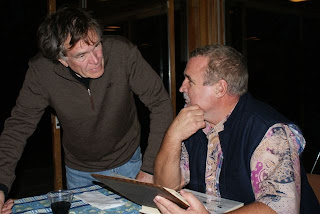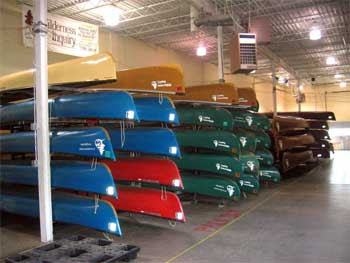 L to R: Bob McKerrow, Will Steger, Paul Schurke, Bob(Ironman)Mantell and Richard Weber.
This image was taken in May of 1985 on the first Steger International Polar expedition . The dog with the sunglasses is Slidre, he went to the North Pole and Greeenland. Slidre was born at the Eureka weather station on Ellesmere Island.
L to R: Bob McKerrow, Will Steger, Paul Schurke, Bob(Ironman)Mantell and Richard Weber.
This image was taken in May of 1985 on the first Steger International Polar expedition . The dog with the sunglasses is Slidre, he went to the North Pole and Greeenland. Slidre was born at the Eureka weather station on Ellesmere Island.
With Will Steger and team, I did some remarkable journeys such as down the Mackenzie River Delta and across the Arctic Ocean to Point Barrow Alaska in 1985 and the following year as a warm up to our unsupported trip to the North Pole, spent 3 months on Baffin Island training in the middle of an Arctic winter, and the late winter on Ward Hunt Island.
The map on the left shows the ARCTIC and our trip is marked in black. The red dot on the left is our starting point at Innuvik and finish point at Point Barrow Alaska.
The 1985 expedition started in Ely Minnesota with Will Steger setting out by dog team in January that year trying to travel 5000 mile . We were to meet him at Arctic Red River, 3500 miles into the jourmey. Bob (Ironman) Mantell, came 1400 miles by dog sled from the Yukon and also met us at Arctic Red River. Paul Schurke, John from Buyck, and I drove with a truckload of 15 huskies for about seven days, and after crossing the US-Canadian border at International Falls, into Ontario, then across the wheat-belt through Manitoba, Saskatchewan, Alberta, the north-eastern sector British Colombia, a corner of the Yukon, up the Alaska Highway, then onto the snow clad Klondike Highway for 489 km. The next part of our road journey with dogs in the truck was up the at times impassable Dempster Highway for 603 km. When the road blocked our way, we continued northwards by driving up frozen rivers. This was a journy with a challenge round every corner and it was John's amazing music of the north that kept us awake as we drove 24/7
We stopped at Fort McPherson and heard first hand of
Albert Johnson, known as the Mad Trapper of Rat River
, a fugitive whose actions eventually sparked off a huge manhunt in the Northwest Territories and Yukon in Northern Canada. The event became a minor media circus as Johnson eluded the Royal Canadian Mounted Police (RCMP) team sent to take him into custody, which ended after a 150 mi (240 km) foot chase and a shootout in which Johnson was fatally wounded on the Eagle River, Yukon.
Travelling for seven days or more with Paul Schurke and John of Buyck with a truck load of howling, hungry huskies were a conversation piece wherever we stopped. We would take them out of their mobile kennels every day for a walk and a feed, and huge crowds would gather round bursting with curiousity.
After five days we crossed the Arctic circle and two days later reached the Innuit settlement of Arctic Red River where Bob Mantell had just arrived with his team of dogs, led by the unmistakable 'Critter' who went on the following year to make Arctic cannine history.
But where was Will Steger? He should have been here to meet us. The next day we got word that Will had just arrived at Innuvik, the next Innuit village down the trail. Here was Will, who I had met for the first time the previous year in England at Ullswater in the Lakes district where we spent 3 days together discussing this journey and the eventual dream of making the North Pole.
Will was in good shape and his team of dogs fit and well. Over a few beers that night, Will told his a harrowing story of how in a blizzard on a large lake, his dogs were startled, and bolted with the sledge, leaving his seperated from his dogs and all his survival equipment. Through sheer survival and navigational skills, Will tracked his team down. Arctic Red River and Innuvik have a special place in my heart as it was where I met Will Steger, Bob Mantell, and Richard Weber for the first time. Richard Weber was a Canadian Olympic skiier and went on to do some of the longest and quickest ever polar journies on ski, a modern-day John Rae.
The 1985 polar team: Bob Mantell, Paul Schurke, Bob McKerrow, Richard Weber and Will Steger leader.
We set off in mid April with three teams of dogs, from Innuvik, on a 1500 miles trip down the Mackenzie River, onto the Arctic Ocean. Here are some excerpts from my diary on the middle part of the journey, crossing from Canada to the USA.
Wed 24 April. Left at 10 am. Made a navigational error. (Close to Herschel Island) Went right at the oil rig ship, frozen in the sea. instead of left. Corrected course after an hour of sledging. We really pushed hard today. Reached the DEW line station at 9.45 pm. 11 and 3/4 hours of travel. Passed a high nunatak, point 33’ on map.There was a log cabin close to the nunatak.
Camped half a mile from DEW line station.
Today was one of those days when it is essential to put your mind in neutral.
(On this page I have a map of Herschel island showing where we found the large ship, Gulf Beaufort, frozen into the ice, and our route.
In 1985 as we moved close to Herschel Island, the sun rolled along the horizon, but never set as Will Steger and his dog team plugged on to point Barrow, Alaska.
Thurs 25 April ANZAC day in New Zealand, the day we commemorate all those in fought in World War I and II.
Packed up and left about 10 am. Today has been designated ice-training and filming day. Dropped into the DEW line station for about an hour or two. Had freshly baked bread and an apple. What a treat ! Jim, an Englishman, who had been in Christchurch, New Zealand in 1952, ran the station. He told us that when this station was built they were not sure whether it was in the US of A or Canada.
Travelled about five miles onto the sea ice and spent about five hours cutting, hacking,, route finding, pushing twisting sledges. We hacked our way through about 50 feet of ice, averaging a height of 10 feet. It was difficult road building, a taste of next year and what we are likely to experience on the way to the North Pole. We need heavier ice axes and a heavy crow bar. A polar bear track wove in and out of the frozen ice-pack. Sam, the DEW line dog, followed us. Sleeping with rifle inside the tent tonight.
Friday 26 April So far the hardest day for me as we step up our pace. 10 am to 10 pm. A long day with poor visibilty, biting wind and quite poor conditions all round. About 8.pm we struck a frozen delta with fresh water covering the ice, and started shattering, creaking and groaning.
Sam followed us today, sometimes getting closer for a better look at us all. Sam was a fine husky that was at the DEW line station and decided to follow us.
A year later Sam was on his way to the North Pole with the team and, in 1989, he was part of Will's South Pole expedition as well, thus making canine history as the one and only dog on expeditions to both ends of the earth. See link to The Most Amazing Sled Dog in Polar History
Sam the husky story
Left, Paul feeding Sam.
At 2pm crossed the Canadian/ US border. Rough, soft conditions. At 6pm, on the other side of Demarcation Bay, discovered an abandoned Innuit settlement. The eiry place exuded remoteness, hardship, sadness and a strong sense of ‘the past.’ Bleached wind and snow blasted crosses, stuck out of a graveyard. Two were easily recognisable:
Annie Died 1913 – 22 years
Alovik Died 1922
Who were these people? What were they like? What did they die of. So many thoughts rushed through my head. Passed Gordon, an abandoned DEW line station and a ship wreck in Demaraction Bay.
Camped for the night on the other side of the large river delta.
Paul Schurke (l) taking a noon sunshot to asxcertain latitude, while I am recording the readings the dogs take a nap.. Arctic Ocean April 1985. Photo: Steger International Polar Expedition
Saturday 27 April. Daylight for 24 hours now. Left about 10.40 am. Takes us about 40 minutes ro hitch up the dogs and break camp. It was smooth going for the first hour, and then crossed some very brittle overflow ice. Will was very concerned about the condition of the ice. Afterwards two hours of slow progress and for the rest of the day we were inside a spit/peninsula, that rounded a point where we pitched camp. The Brooks range was a stunning backdrop all day. The highlight of the day was when Richard caught Sam. He’s going to be a fine husky. The dogs pulled very well today. Passed a few more abandoned Innuit settlements. The sun set about 11pm, but it never got dark.
Ann Bancroft and the runaway sled dog Sam in 1986
Also from my 1985 journal.are the names and order of Will's dog team.
CHESTER
BLACKIE JUNIOR
SLYDER ZAP
GOLIATH CHUCHI JAGER LIEF
SAM HANK
Why was this the most remarkable polar journey in my life? Starting in Minnesota USA, drving a week through Canada to the Arctic gave me a look at a swathe of scenicly beautiful parts of the US, Canada and Arctic Canada by road, and then a 1500 mile trip with dogs and sledges where we met indigenous Indian families and later trappers, the Innuit in remote villages. Sharing a team of dogs and a tent at night with legendary Bob Mantell was a remarkable experience, and learning dog drving in the north, which is very different to what I had learned in Antarctica. As we cooked an unhurried breakfast or evening meal, I would listen to a very modest man tell me of his many winter journeys by dog team in the Arctic. Paul Schurke, Richard Weber and Will Steger were all remarkable travelling companions with insatiable appetites for exploring, and each taught me some of the finer points of arctic travel. I will always be indebted to these caring and tough individuals.
I will post a few more excerpts on this trip later.


















































